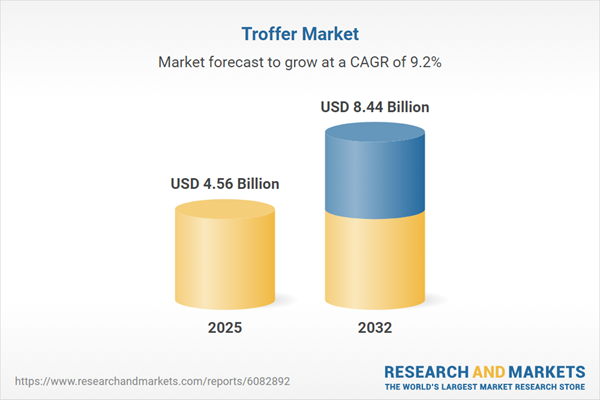Speak directly to the analyst to clarify any post sales queries you may have.
Troffer lighting is positioned at the forefront of modern commercial and institutional illumination, responding to the evolving needs of efficiency-focused organizations and fast-changing regulatory environments. This report presents senior executives with an actionable assessment of the troffer lighting market’s dynamics, emerging trends, and key opportunities for sustainable, technology-driven growth.
Market Snapshot: Troffer Lighting Market Growth and Outlook
The global troffer lighting market was valued at USD 4.17 billion in 2024 and is projected to reach USD 4.56 billion in 2025. With a CAGR of 9.18%, the market is forecast to achieve a total size of USD 8.44 billion by 2032. This growth reflects accelerating adoption of energy-efficient and network-enabled lighting systems across corporate, institutional, and industrial settings, propelled by evolving regulatory standards and rising demand for human-centric workplace environments.
Scope & Segmentation: Comprehensive Troffer Market Analysis
This report examines the troffer lighting sector with detailed segmentation across product, distribution, and application channels, providing a foundation for strategic decision-making.
- Light Source Types: Fluorescent (including T5 and T8), LED (offered in cool white, daylight, and warm white color profiles)
- Mounting Configurations: Recessed and surface-mounted fixtures designed to address varying architectural and retrofit requirements
- Wattage Range: Categories include installations under 20 watts, midrange applications between 20 and 40 watts, and high-output fixtures for intensive illumination
- Distribution Channels: Direct sales via OEM contracts and project-based orders; distributors through electrical wholesalers and lighting specialists; online through e-commerce and manufacturer websites
- Application Environments: Hospitality, industrial facilities (manufacturing, warehousing), institutional sectors (education, healthcare, government), office settings, and retail spaces
- Geographical Regions: Americas (United States, Canada, Mexico, Brazil, Argentina, Chile, Colombia, Peru), Europe, Middle East & Africa (including United Kingdom, Germany, France, GCC states, South Africa, Nigeria, and others), and Asia-Pacific (China, India, Japan, Australia, South Korea, Indonesia, Thailand, Malaysia, Singapore, Taiwan)
- Key Technology Focus: Advancements in solid-state lighting, optical management, digital controls, and connected luminaires
Key Takeaways for Senior Decision-Makers
- Troffer lighting advancements are transforming commercial lighting through enhanced control, energy conservation, and improved occupant comfort.
- Transitioning from legacy fluorescent to LED-based systems introduces opportunities for remote monitoring, color tuning, and integration with building management platforms.
- Manufacturers must address increasing demands for product modularity, lifecycle sustainability, and differentiated after-sales services to remain competitive.
- Emerging players are leveraging software-driven innovation, offering data analytics and maintenance capabilities as value-added services
- Regional regulatory frameworks and infrastructure investments significantly influence adoption and supply chain localization, especially in high-growth Asia-Pacific and EMEA corridors.
- Partnerships across lighting, controls, and analytics providers foster holistic solutions, expanding addressable markets and responding to evolving customer expectations.
Tariff Impact: Navigating New Trade Measures
The introduction of revised United States tariffs in 2025 has affected supply chain strategies and cost structures across the troffer segment. Manufacturers are localizing production and adjusting procurement of lighting components and materials to mitigate tariff pressures. These changes prompt investments in tooling and quality processes, while distributors adapt inventory practices to manage volatility. Maintaining resilience now relies on diversifying suppliers and optimizing logistics to manage continued trade disruption risks.
Methodology & Data Sources
This report is based on expert interviews with lighting executives, facility engineers, and end-user representatives, supplemented by analysis of trade filings, peer-reviewed literature, and regulatory documentation. Validation of supply chain mappings and impact assessments was conducted through industry consultations and independent peer reviews. Quantitative data was triangulated from leading market databases to ensure integrity and actionable insight.
Why This Report Matters
- Enables executives to identify actionable strategies for technology adoption, supply chain risk mitigation, and regulatory compliance.
- Delivers practical segmentation and geographic insights to support tailored go-to-market and portfolio decisions.
- Supports long-term investment prioritization through credible, data-driven intelligence on technology, policy, and competitive dynamics.
Conclusion
Troffer lighting markets are evolving rapidly amid technology shifts and regulatory changes. Strategic adaptation across product, supply chain, and channel partnerships will be central to sustained success. Senior leaders equipped with these insights are positioned to navigate complexity, drive performance, and unlock market potential.
Table of Contents
3. Executive Summary
4. Market Overview
7. Cumulative Impact of Artificial Intelligence 2025
Companies Mentioned
The companies profiled in this Troffer market report include:- Signify N.V.
- Acuity Brands, Inc.
- Eaton Corporation plc
- Zumtobel Group AG
- OSRAM Licht AG
- Hubbell Incorporated
- Cree, Inc.
- Panasonic Corporation
- Fagerhult AB
- Schneider Electric SE
Table Information
| Report Attribute | Details |
|---|---|
| No. of Pages | 184 |
| Published | October 2025 |
| Forecast Period | 2025 - 2032 |
| Estimated Market Value ( USD | $ 4.56 Billion |
| Forecasted Market Value ( USD | $ 8.44 Billion |
| Compound Annual Growth Rate | 9.1% |
| Regions Covered | Global |
| No. of Companies Mentioned | 11 |









